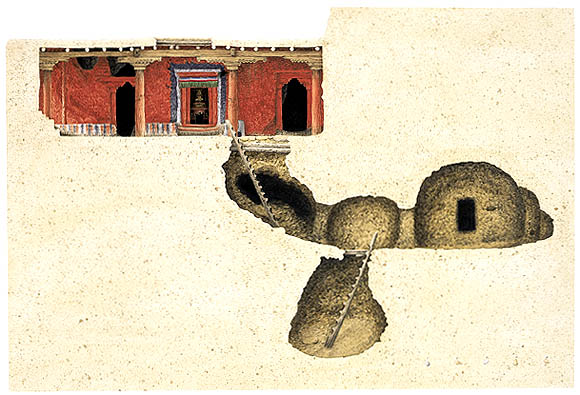
Minjhi Lhakhang
65 x 91 cm
| Between the villages of Braga and Te in the valley of the Narshing
Chu are some large ourcroppings of sedimentary deposits riddled with eroded caves. This painting is a measured section through a hillock where a temple has been built into what seem like caves from a much earlier period. One enters the hill through a small opening at the base which leads into the bottom cave, and then ascends on notched-log ladders to the temple space above. "Like Tangbe, Braga is reported to have been founded by migrants from Manang who gave the name of their original home to the new settlement. Braga is a large village a short distance south of the main town of Manang. In this case, the Braga clan are said to be descended from a family who fled their home to escape reprisals for a murder that they had committed there, bringing with them their clan god. The god in question is housed in a small temple, called sMan-rtis lha-khang [ Mentsi Lhakhang], that is the common property of the six households of the Braga clan (three of which are located in Braga itself and three in Cikyab). The temple itself is a mudbrick building inside a cave a short distance up the Narshing Chu. A gap between the temple and the cave wall permits circum-ambulation of the construction. The temple walls are decorated with paintings of saints and Buddhas, and clay images include figures of Avalokitesvara and the five Kulesa. The clan god itself is a stone hexahedron about 75 cm high with a surface of perhaps 30 cm' , covered in oil and topped with a few smaller stones. The six households take it in turns, one month at a time, to make daily offerings in the temple. (Interestingly, contrary to the usual practice of offering water (yonchab) in the morning and lighting a lamp in the evening, the clan has contracted the two rituals into a single occasion, performed in the midafternoon.)": Charles Ramble and Christian Seeber, "Dead and Living Settlements in the Shoyul of Mustang." in Ancient Nepal: No 138, September, 1995, p. 112. "Among the murals and sculptures some remnant paintings from the 12th or 13th centuries perhaps date the temple's foundation." Mary Slusser |
